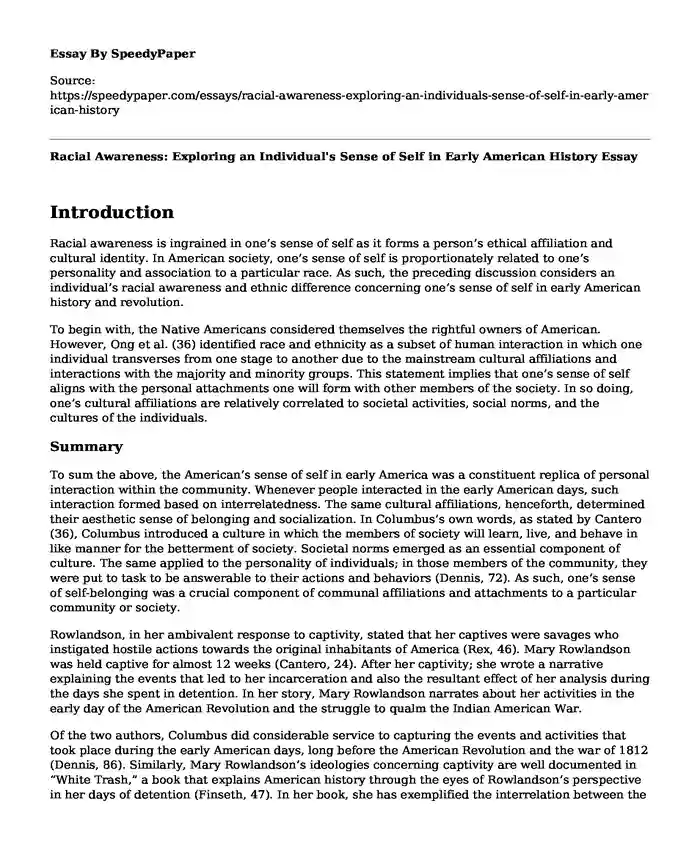
| Type of paper: | Essay |
| Categories: | Race Culture American history |
| Pages: | 3 |
| Wordcount: | 657 words |
Introduction
Racial awareness is ingrained in one’s sense of self as it forms a person’s ethical affiliation and cultural identity. In American society, one’s sense of self is proportionately related to one’s personality and association to a particular race. As such, the preceding discussion considers an individual’s racial awareness and ethnic difference concerning one’s sense of self in early American history and revolution.
To begin with, the Native Americans considered themselves the rightful owners of American. However, Ong et al. (36) identified race and ethnicity as a subset of human interaction in which one individual transverses from one stage to another due to the mainstream cultural affiliations and interactions with the majority and minority groups. This statement implies that one’s sense of self aligns with the personal attachments one will form with other members of the society. In so doing, one’s cultural affiliations are relatively correlated to societal activities, social norms, and the cultures of the individuals.
Summary
To sum the above, the American’s sense of self in early America was a constituent replica of personal interaction within the community. Whenever people interacted in the early American days, such interaction formed based on interrelatedness. The same cultural affiliations, henceforth, determined their aesthetic sense of belonging and socialization. In Columbus’s own words, as stated by Cantero (36), Columbus introduced a culture in which the members of society will learn, live, and behave in like manner for the betterment of society. Societal norms emerged as an essential component of culture. The same applied to the personality of individuals; in those members of the community, they were put to task to be answerable to their actions and behaviors (Dennis, 72). As such, one’s sense of self-belonging was a crucial component of communal affiliations and attachments to a particular community or society.
Rowlandson, in her ambivalent response to captivity, stated that her captives were savages who instigated hostile actions towards the original inhabitants of America (Rex, 46). Mary Rowlandson was held captive for almost 12 weeks (Cantero, 24). After her captivity; she wrote a narrative explaining the events that led to her incarceration and also the resultant effect of her analysis during the days she spent in detention. In her story, Mary Rowlandson narrates about her activities in the early day of the American Revolution and the struggle to qualm the Indian American War.
Of the two authors, Columbus did considerable service to capturing the events and activities that took place during the early American days, long before the American Revolution and the war of 1812 (Dennis, 86). Similarly, Mary Rowlandson’s ideologies concerning captivity are well documented in “White Trash,” a book that explains American history through the eyes of Rowlandson’s perspective in her days of detention (Finseth, 47). In her book, she has exemplified the interrelation between the early Indians and her indifference between savagery and the accounts of civilizations in early America.
In their varied documentation, Rowlandson relates to her captivity with the Native Indians during the reign of King Philips. Christopher Columbus, on the other hand, lived up to his expedition experience through the American continent. His experience shaped his affiliations with the Native Americans, and his identity with Americans swayed to the extent that he associated himself with the Americans. On the same, Mary Rowlandson chose to identify herself as an American due to her long spell in captivity.
Works Cited
Cantero-Reyes, Nataly. Redemption and revenge: The legacies of Mary Rowlandson and Hannah Duston. Diss. 2019. https://hdl.handle.net/11244/324820
Dennis, Matthew. Red, White, And Blue Letter Days: An American Calendar. Cornell University Press, 2018.
Finseth, I. F. The American Civil War: A Literary and Historical Anthology. Routledge, 2020.
Ong, Paul M., and Silvia R. Gonzalez. Uneven Urbanscape: Spatial Structures and Ethnoracial Inequality. Cambridge University Press, 2019.
Rex, Cathy. Anglo-American Women Writers and Representations of Indianness, 1629-1824. Routledge, 2016.
Cite this page
Racial Awareness: Exploring an Individual's Sense of Self in Early American History. (2023, Sep 13). Retrieved from https://speedypaper.com/essays/racial-awareness-exploring-an-individuals-sense-of-self-in-early-american-history
Request Removal
If you are the original author of this essay and no longer wish to have it published on the SpeedyPaper website, please click below to request its removal:
- Free Essay Sample about Short Fiction of Kate Chopin
- Free Essay Sample on Biblical Perspective on Gender
- Essay Sample on Emotional Intelligence and Effective Leadership
- Free Essay on the Issue of Undocumented Students
- Free Essay Defending Mary Wollstonecraft's A Vindication of the Rights of Women
- Essay Sample on Marcus Garvey's Dealings and Accomplishments
- Medieval Crisis to Renaissance Revival: Unveiling the Transformative Epoch - Paper Example
Popular categories




